The nervous system is the major controlling, regulatory, and communicating system in the body. Its activities can be grouped together as three general, overlapping functions:
- Sensory
- Integrative
- Motor
Millions of sensory receptors detect changes, called stimuli, which occur inside and outside the body. They monitor such things as temperature, light, and sound from the external environment. Inside the body, the internal environment, receptors detect variations in pressure, pH, carbon dioxide concentration, and the levels of various electrolytes. All of this gathered information is called sensory input.
Sensory input is converted into electrical signals called nerve impulses that are transmitted to the brain. There the signals are brought together to create sensations, to produce thoughts, or to add to memory. Decisions are made each moment based on the sensory input. This is integration.
Based on the sensory input and integration, the nervous system responds by sending signals to muscles, causing them to contract, or to glands, causing them to produce secretions. Muscles and glands are called effectors because they cause an effect in response to directions from the nervous system. This is the motor output or motor function.
Nerve Tissues
Although the nervous system is very complex, there are only two main types of cells in nerve tissue. The actual nerve cell is the neuron. It is the "conducting" cell that transmits impulses and the structural unit of the nervous system. The other type of cell is neuroglia, or glial, cell. The word "neuroglia" means "nerve glue." These cells are nonconductive and provide a support system for the neurons. They are a special type of "connective tissue" for the nervous system.
Neurons
Neurons, or nerve cells, carry out the functions of the nervous system by conducting nerve impulses. They are highly specialized and amitotic. This means that if a neuron is destroyed, it cannot be replaced because neurons do not go through mitosis. The image below illustrates the structure of a typical neuron.

Each neuron has three basic parts: cell body (soma), one or more dendrites, and a single axon.
Cell Body
In many ways, the cell body is similar to other types of cells. It has a nucleus with at least one nucleolus and contains many of the typical cytoplasmic organelles. It lacks centrioles, however. Because centrioles function in cell division, the fact that neurons lack these organelles is consistent with the amitotic nature of the cell.
Dendrites
Dendrites and axons are cytoplasmic extensions, or processes, that project from the cell body. They are sometimes referred to as fibers. Dendrites are usually, but not always, short and branching, which increases their surface area to receive signals from other neurons. The number of dendrites on a neuron varies. They are called afferent processes because they transmit impulses to the neuron cell body. There is only one axon that projects from each cell body. It is usually elongated and because it carries impulses away from the cell body, it is called an efferent process.
Axon
An axon may have infrequent branches called axon collaterals. Axons and axon collaterals terminate in many short branches or telodendria. The distal ends of the telodendria are slightly enlarged to form synaptic bulbs. Many axons are surrounded by a segmented, white, fatty substance called myelin or the myelin sheath. Myelinated fibers make up the white matter in the CNS, while cell bodies and unmyelinated fibers make the gray matter. The unmyelinated regions between the myelin segments are called the nodes of Ranvier.
In the peripheral nervous system, the myelin is produced by Schwann cells. The cytoplasm, nucleus, and outer cell membrane of the Schwann cell form a tight covering around the myelin and around the axon itself at the nodes of Ranvier. This covering is the neurilemma, which plays an important role in the regeneration of nerve fibers. In the CNS, oligodendrocytes produce myelin, but there is no neurilemma, which is why fibers within the CNS do not regenerate.
Functionally, neurons are classified as afferent, efferent, or interneurons (association neurons) according to the direction in which they transmit impulses relative to the central nervous system. Afferent, or sensory, neurons carry impulses from peripheral sense receptors to the CNS. They usually have long dendrites and relatively short axons. Efferent, or motor, neurons transmit impulses from the CNS to effector organs such as muscles and glands. Efferent neurons usually have short dendrites and long axons. Interneurons, or association neurons, are located entirely within the CNS in which they form the connecting link between the afferent and efferent neurons. They have short dendrites and may have either a short or long axon.
Neuroglia
Neuroglia cells do not conduct nerve impulses, but instead, they support, nourish, and protect the neurons. They are far more numerous than neurons and, unlike neurons, are capable of mitosis.
The nervous system as a whole is divided into two subdivisions: the central nervous system (CNS) and the peripheral nervous system (PNS).
The Central Nervous System
The brain and spinal cord are the organs of the central nervous system. Because they are so vitally important, the brain and spinal cord, located in the dorsal body cavity, are encased in bone for protection. The brain is in the cranial vault, and the spinal cord is in the vertebral canal of the vertebral column. Although considered to be two separate organs, the brain and spinal cord are continuous at the foramen magnum. In addition to bone, the CNS is surrounded by connective tissue membranes, called meninges, and by cerebrospinal fluid.
Meninges
 There are three layers of meninges around the brain and spinal cord. The outer layer, the dura mater, is tough white fibrous connective tissue. The middle layer of meninges is arachnoid, which resembles a cobweb in appearance, is a thin layer with numerous threadlike strands that attach it to the innermost layer. The space under the arachnoid, the subarachnoid space, is filled with cerebrospinal fluid and contains blood vessels. The pia mater is the innermost layer of meninges. This thin, delicate membrane is tightly bound to the surface of the brain and spinal cord and cannot be dissected away without damaging the surface.
There are three layers of meninges around the brain and spinal cord. The outer layer, the dura mater, is tough white fibrous connective tissue. The middle layer of meninges is arachnoid, which resembles a cobweb in appearance, is a thin layer with numerous threadlike strands that attach it to the innermost layer. The space under the arachnoid, the subarachnoid space, is filled with cerebrospinal fluid and contains blood vessels. The pia mater is the innermost layer of meninges. This thin, delicate membrane is tightly bound to the surface of the brain and spinal cord and cannot be dissected away without damaging the surface.
Meningiomas are tumors of the nerve tissue covering the brain and spinal cord. Although meningiomas are usually not likely to spread, physicians often treat them as though they were malignant to treat symptoms that may develop when a tumor applies pressure to the brain.
Brain
The brain is divided into the cerebrum, diencephalons, brain stem, and cerebellum.
Cerebrum
 The largest and most obvious portion of the brain is the cerebrum, which is divided by a deep longitudinal fissure into two cerebral hemispheres. The two hemispheres are two separate entities but are connected by an arching band of white fibers, called the corpus callosum that provides a communication pathway between the two halves.
The largest and most obvious portion of the brain is the cerebrum, which is divided by a deep longitudinal fissure into two cerebral hemispheres. The two hemispheres are two separate entities but are connected by an arching band of white fibers, called the corpus callosum that provides a communication pathway between the two halves.
Each cerebral hemisphere is divided into five lobes, four of which have the same name as the bone over them: the frontal lobe, the parietal lobe, the occipital lobe, and the temporal lobe. A fifth lobe, the insula or Island of Reil, lies deep within the lateral sulcus.
Diencephalon
 The diencephalon is centrally located and is nearly surrounded by the cerebral hemispheres. It includes the thalamus, hypothalamus, and epithalamus. The thalamus, about 80 percent of the diencephalon, consists of two oval masses of gray matter that serve as relay stations for sensory impulses, except for the sense of smell, going to the cerebral cortex. The hypothalamus is a small region below the thalamus, which plays a key role in maintaining homeostasis because it regulates many visceral activities. The epithalamus is the most dorsal portion of the diencephalon. This small gland is involved with the onset of puberty and rhythmic cycles in the body. It is like a biological clock.
The diencephalon is centrally located and is nearly surrounded by the cerebral hemispheres. It includes the thalamus, hypothalamus, and epithalamus. The thalamus, about 80 percent of the diencephalon, consists of two oval masses of gray matter that serve as relay stations for sensory impulses, except for the sense of smell, going to the cerebral cortex. The hypothalamus is a small region below the thalamus, which plays a key role in maintaining homeostasis because it regulates many visceral activities. The epithalamus is the most dorsal portion of the diencephalon. This small gland is involved with the onset of puberty and rhythmic cycles in the body. It is like a biological clock.
Brain Stem
The brain stem is the region between the diencephalon and the spinal cord. It consists of three parts: midbrain, pons, and medulla oblongata. The midbrain is the most superior portion of the brain stem. The pons is the bulging middle portion of the brain stem. This region primarily consists of nerve fibers that form conduction tracts between the higher brain centers and spinal cord. The medulla oblongata, or simply medulla, extends inferiorly from the pons. It is continuous with the spinal cord at the foramen magnum. All the ascending (sensory) and descending (motor) nerve fibers connecting the brain and spinal cord pass through the medulla.

Cerebellum
The cerebellum, the second largest portion of the brain, is located below the occipital lobes of the cerebrum. Three paired bundles of myelinated nerve fibers, called cerebellar peduncles, form communication pathways between the cerebellum and other parts of the central nervous system.
Spinal Cord
The spinal cord extends from the foramen magnum at the base of the skull to the level of the first lumbar vertebra. The cord is continuous with the medulla oblongata at the foramen magnum. Like the brain, the spinal cord is surrounded by bone, meninges, and cerebrospinal fluid.
The spinal cord is divided into 31 segments with each segment giving rise to a pair of spinal nerves. At the distal end of the cord, many spinal nerves extend beyond the conus medullaris to form a collection that resembles a horse's tail. This is the cauda equina. In cross section, the spinal cord appears oval in shape.
The spinal cord has two main functions:
- Serving as a conduction pathway for impulses going to and from the brain. Sensory impulses travel to the brain on ascending tracts in the cord. Motor impulses travel on descending tracts.
- Serving as a reflex center. The reflex arc is the functional unit of the nervous system. Reflexes are responses to stimuli that do not require conscious thought and consequently, they occur more quickly than reactions that require thought processes. For example, with the withdrawal reflex, the reflex action withdraws the affected part before you are aware of the pain. Many reflexes are mediated in the spinal cord without going to the higher brain centers.
The Peripheral Nervous System
The peripheral nervous system consists of the nerves that branch out from the brain and spinal cord. These nerves form the communication network between the CNS and the body parts. The peripheral nervous system is further subdivided into the somatic nervous system and the autonomic nervous system. The somatic nervous system consists of nerves that go to the skin and muscles and is involved in conscious activities. The autonomic nervous system consists of nerves that connect the CNS to the visceral organs such as the heart, stomach, and intestines. It mediates unconscious activities.
Structure of a Nerve
 A nerve contains bundles of nerve fibers, either axons or dendrites, surrounded by connective tissue. Sensory nerves contain only afferent fibers, long dendrites of sensory neurons. Motor nerves have only efferent fibers, long axons of motor neurons. Mixed nerves contain both types of fibers.
A nerve contains bundles of nerve fibers, either axons or dendrites, surrounded by connective tissue. Sensory nerves contain only afferent fibers, long dendrites of sensory neurons. Motor nerves have only efferent fibers, long axons of motor neurons. Mixed nerves contain both types of fibers.
A connective tissue sheath called the epineurium surrounds each nerve. Each bundle of nerve fibers is called a fasciculus and is surrounded by a layer of connective tissue called the perineurium. Within the fasciculus, each individual nerve fiber, with its myelin and neurilemma, is surrounded by connective tissue called the endoneurium. A nerve may also have blood vessels enclosed in its connective tissue wrappings.
Cranial Nerves
 Twelve pairs of cranial nerves emerge from the inferior surface of the brain. All of these nerves, except the vagus nerve, pass through foramina of the skull to innervate structures in the head, neck, and facial region.
Twelve pairs of cranial nerves emerge from the inferior surface of the brain. All of these nerves, except the vagus nerve, pass through foramina of the skull to innervate structures in the head, neck, and facial region.
The cranial nerves are designated both by name and by Roman numerals, according to the order in which they appear on the inferior surface of the brain. Most of the nerves have both sensory and motor components. Three of the nerves are associated with the special senses of smell, vision, hearing, and equilibrium and have only sensory fibers. Five other nerves are primarily motor in function but do have some sensory fibers for proprioception. The remaining four nerves consist of significant amounts of both sensory and motor fibers.
Spinal Nerves
Thirty-one pairs of spinal nerves emerge laterally from the spinal cord. Each pair of nerves corresponds to a segment of the cord and they are named accordingly. This means there are 8 cervical nerves, 12 thoracic nerves, 5 lumbar nerves, 5 sacral nerves, and 1 coccygeal nerve.
Each spinal nerve is connected to the spinal cord by a dorsal root and a ventral root. The cell bodies of the sensory neurons are in the dorsal root ganglion, but the motor neuron cell bodies are in the gray matter. The two roots join to form the spinal nerve just before the nerve leaves the vertebral column. Because all spinal nerves have both sensory and motor components, they are all mixed nerves.
Autonomic Nervous System
The autonomic nervous system is a visceral efferent system, which means it sends motor impulses to the visceral organs. It functions automatically and continuously, without conscious effort, to innervate smooth muscle, cardiac muscle, and glands. It is concerned with heart rate, breathing rate, blood pressure, body temperature, and other visceral activities that work together to maintain homeostasis.
The autonomic nervous system has two parts, the sympathetic division and the parasympathetic division. Many visceral organs are supplied with fibers from both divisions. In this case, one stimulates and the other inhibits. This antagonistic functional relationship serves as a balance to help maintain homeostasis.
source:
SEER's Training Website.



















 The thymus is a gland needed early in life for normal immune function. It is very large just after a child is born and weighs its greatest when a child reaches puberty. Then its tissue is replaced by fat. The thymus gland secretes hormones called humoral factors. These hormones help to develop the lymphoid system, which is a system throughout the body that help it to reach a mature immune response in cells to protect them from invading bodies, like bacteria.
The thymus is a gland needed early in life for normal immune function. It is very large just after a child is born and weighs its greatest when a child reaches puberty. Then its tissue is replaced by fat. The thymus gland secretes hormones called humoral factors. These hormones help to develop the lymphoid system, which is a system throughout the body that help it to reach a mature immune response in cells to protect them from invading bodies, like bacteria. Scientists are still learning how the pineal gland works. They have found one hormone so far that is produced by this gland: melatonin. Melatonin may stop the action of (inhibit) the hormones that produce gonadotropin, which causes the ovaries and testes to develop and function. It may also help to control sleep patterns.
Scientists are still learning how the pineal gland works. They have found one hormone so far that is produced by this gland: melatonin. Melatonin may stop the action of (inhibit) the hormones that produce gonadotropin, which causes the ovaries and testes to develop and function. It may also help to control sleep patterns. Males have twin reproductive glands, called testes, that produce the hormone testosterone. Testosterone helps a boy develop and then maintain his sexual traits. During puberty, testosterone helps to bring about the physical changes that turn a boy into an adult male, such as growth of the penis and testes, growth of facial and pubic hair, deepening of the voice, increase in muscle mass and strength, and increase in height. Throughout adult life, testosterone helps maintain sex drive, sperm production, male hair patterns, muscle mass, and bone mass.
Males have twin reproductive glands, called testes, that produce the hormone testosterone. Testosterone helps a boy develop and then maintain his sexual traits. During puberty, testosterone helps to bring about the physical changes that turn a boy into an adult male, such as growth of the penis and testes, growth of facial and pubic hair, deepening of the voice, increase in muscle mass and strength, and increase in height. Throughout adult life, testosterone helps maintain sex drive, sperm production, male hair patterns, muscle mass, and bone mass. The two most important hormones of a woman's twin reproductive glands, the ovaries, are estrogen and progesterone. These hormones are responsible for developing and maintaining female sexual traits, as well as maintaining a pregnancy. Along with the pituitary gonadotropins (luteinizing hormone or LH and follicle-stimulating hormone or FSH), they also control the menstrual cycle. The ovaries also produce inhibin, a protein that curbs (inhibits) the release of follicle-stimulating hormone from the anterior pituitary and helps control egg development.
The two most important hormones of a woman's twin reproductive glands, the ovaries, are estrogen and progesterone. These hormones are responsible for developing and maintaining female sexual traits, as well as maintaining a pregnancy. Along with the pituitary gonadotropins (luteinizing hormone or LH and follicle-stimulating hormone or FSH), they also control the menstrual cycle. The ovaries also produce inhibin, a protein that curbs (inhibits) the release of follicle-stimulating hormone from the anterior pituitary and helps control egg development.  The thyroid is a small gland inside the neck, located in front of your breathing airway (trachea) and below your Adam's apple. The thyroid hormones control your metabolism, which is the body's ability to break down food and store it as energy and the ability to break down food into waste products with a release of energy in the process. The thyroid produces two hormones, T3 (called tri-iodothyronine) and T4 (called thyroxine).
The thyroid is a small gland inside the neck, located in front of your breathing airway (trachea) and below your Adam's apple. The thyroid hormones control your metabolism, which is the body's ability to break down food and store it as energy and the ability to break down food into waste products with a release of energy in the process. The thyroid produces two hormones, T3 (called tri-iodothyronine) and T4 (called thyroxine). Each adrenal gland is actually two endocrine organs. The outer portion is called the adrenal cortex. The inner portion is called the adrenal medulla. The hormones of the adrenal cortex are essential for life. The types of hormones secreted by the adrenal medulla are not.
Each adrenal gland is actually two endocrine organs. The outer portion is called the adrenal cortex. The inner portion is called the adrenal medulla. The hormones of the adrenal cortex are essential for life. The types of hormones secreted by the adrenal medulla are not. Located behind the thyroid gland are four tiny parathyroid glands. These make hormones that help control calcium and phosphorous levels in the body. The parathyroid glands are necessary for proper bone development. In response to too little calcium in the diet, the parathyroid glands make parathyroid hormone, or PTH, that takes calcium from bones so that it will be available in the blood for nerve conduction and muscle contraction.
Located behind the thyroid gland are four tiny parathyroid glands. These make hormones that help control calcium and phosphorous levels in the body. The parathyroid glands are necessary for proper bone development. In response to too little calcium in the diet, the parathyroid glands make parathyroid hormone, or PTH, that takes calcium from bones so that it will be available in the blood for nerve conduction and muscle contraction. The pancreas is a large gland behind your stomach that helps the body to maintain healthy blood sugar (glucose) levels. The pancreas secretes insulin, a hormone that helps glucose move from the blood into the cells where it is used for energy. The pancreas also secretes glucagon when the blood sugar is low. Glucagon tells the liver to release glucose, stored in the liver as glycogen, into the bloodstream.
The pancreas is a large gland behind your stomach that helps the body to maintain healthy blood sugar (glucose) levels. The pancreas secretes insulin, a hormone that helps glucose move from the blood into the cells where it is used for energy. The pancreas also secretes glucagon when the blood sugar is low. Glucagon tells the liver to release glucose, stored in the liver as glycogen, into the bloodstream.

 There are three layers of meninges around the brain and spinal cord. The outer layer, the dura mater, is tough white fibrous connective tissue. The middle layer of meninges is arachnoid, which resembles a cobweb in appearance, is a thin layer with numerous threadlike strands that attach it to the innermost layer. The space under the arachnoid, the subarachnoid space, is filled with cerebrospinal fluid and contains blood vessels. The pia mater is the innermost layer of meninges. This thin, delicate membrane is tightly bound to the surface of the brain and spinal cord and cannot be dissected away without damaging the surface.
There are three layers of meninges around the brain and spinal cord. The outer layer, the dura mater, is tough white fibrous connective tissue. The middle layer of meninges is arachnoid, which resembles a cobweb in appearance, is a thin layer with numerous threadlike strands that attach it to the innermost layer. The space under the arachnoid, the subarachnoid space, is filled with cerebrospinal fluid and contains blood vessels. The pia mater is the innermost layer of meninges. This thin, delicate membrane is tightly bound to the surface of the brain and spinal cord and cannot be dissected away without damaging the surface.  The largest and most obvious portion of the brain is the cerebrum, which is divided by a deep longitudinal fissure into two cerebral hemispheres. The two hemispheres are two separate entities but are connected by an arching band of white fibers, called the corpus callosum that provides a communication pathway between the two halves.
The largest and most obvious portion of the brain is the cerebrum, which is divided by a deep longitudinal fissure into two cerebral hemispheres. The two hemispheres are two separate entities but are connected by an arching band of white fibers, called the corpus callosum that provides a communication pathway between the two halves. The diencephalon is centrally located and is nearly surrounded by the cerebral hemispheres. It includes the thalamus, hypothalamus, and epithalamus. The thalamus, about 80 percent of the diencephalon, consists of two oval masses of gray matter that serve as relay stations for sensory impulses, except for the sense of smell, going to the cerebral cortex. The hypothalamus is a small region below the thalamus, which plays a key role in maintaining homeostasis because it regulates many visceral activities. The epithalamus is the most dorsal portion of the diencephalon. This small gland is involved with the onset of puberty and rhythmic cycles in the body. It is like a biological clock.
The diencephalon is centrally located and is nearly surrounded by the cerebral hemispheres. It includes the thalamus, hypothalamus, and epithalamus. The thalamus, about 80 percent of the diencephalon, consists of two oval masses of gray matter that serve as relay stations for sensory impulses, except for the sense of smell, going to the cerebral cortex. The hypothalamus is a small region below the thalamus, which plays a key role in maintaining homeostasis because it regulates many visceral activities. The epithalamus is the most dorsal portion of the diencephalon. This small gland is involved with the onset of puberty and rhythmic cycles in the body. It is like a biological clock. 
 A nerve contains bundles of nerve fibers, either axons or dendrites, surrounded by connective tissue. Sensory nerves contain only afferent fibers, long dendrites of sensory neurons. Motor nerves have only efferent fibers, long axons of motor neurons. Mixed nerves contain both types of fibers.
A nerve contains bundles of nerve fibers, either axons or dendrites, surrounded by connective tissue. Sensory nerves contain only afferent fibers, long dendrites of sensory neurons. Motor nerves have only efferent fibers, long axons of motor neurons. Mixed nerves contain both types of fibers.  Twelve pairs of cranial nerves emerge from the inferior surface of the brain. All of these nerves, except the vagus nerve, pass through foramina of the skull to innervate structures in the head, neck, and facial region.
Twelve pairs of cranial nerves emerge from the inferior surface of the brain. All of these nerves, except the vagus nerve, pass through foramina of the skull to innervate structures in the head, neck, and facial region.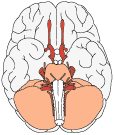
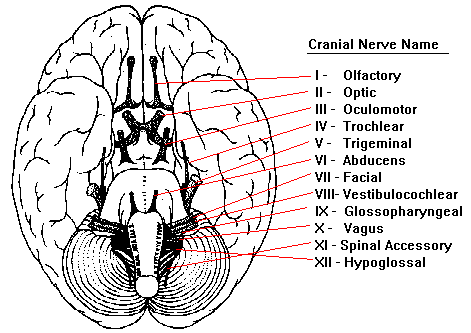

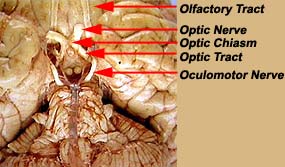
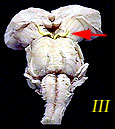
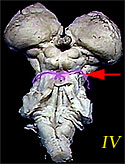
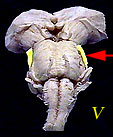
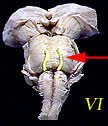
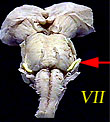
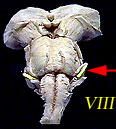
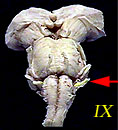
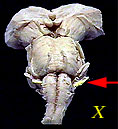
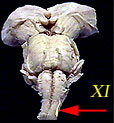
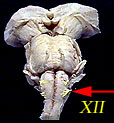

 Still can't remember the cranial nerves? Perhaps you need some
Still can't remember the cranial nerves? Perhaps you need some 
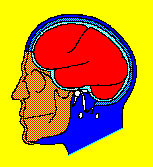 To test the sensory part of the trigeminal nerve, lightly touch various parts of your partner's face with piece of cotton or a blunt object. Be careful not to touch your partner's eyes. Although much of the mouth and teeth are innervated by the trigeminal nerve, don't put anything into your subject's mouth.
To test the sensory part of the trigeminal nerve, lightly touch various parts of your partner's face with piece of cotton or a blunt object. Be careful not to touch your partner's eyes. Although much of the mouth and teeth are innervated by the trigeminal nerve, don't put anything into your subject's mouth. 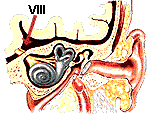 Vestibulocochlear Nerve (VIII)
Vestibulocochlear Nerve (VIII)